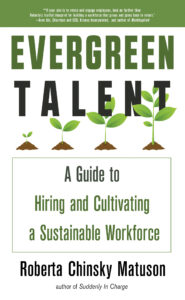Cultivate a Sustainable Workforce
Not many people think that finding and keeping the very best talent is easy. I’m always on the hunt for ideas to improve engagement at all levels.
Organizations must constantly assess and up the people game or risk seeing the very best employees leave. In Evergreen Talent, Roberta Matuson, CEO of Matuson Consulting, shares strategies for attracting and keeping talent in a sustainable, long-term way.
For those who haven’t yet read your new book, what is “evergreen talent”?
Evergreen Talent is a new way of thinking about the talent pool in your organization. It’s about seeding your organization with the right people, nurturing and growing this talent, and creating a sustainable workforce that will stand tall for years to come.
What are some ways that leaders inadvertently stunt employee growth?
Micromanagers are found in just about every organization and are stifling employee growth.
Most leaders think that giving people more money is the key to employee happiness, when in fact, what people really want is autonomy. Imagine trying to grow when your boss is overshadowing everything you do. He insists on approving every email prior to you hitting the send button. He rewrites everything you submit and doesn’t allow you to make a move without checking with him first.
Another way that leaders inadvertently stunt employee growth is refusing to support an employee’s effort to grow. They’re not willing to invest in skill building, nor are they willing to provide people with access to a coach. Most won’t even spend the $99 required for their people to attend a one day session at the local Holiday Inn. Of course, these same leaders are shocked when their people hand in their two-week notice.
How should leaders rethink their own talent mindset?
Hiring is the responsibility of every leader. This is not something that can be delegated to HR. Leaders must also give up their preconceived notion regarding the perfect candidate. There is no such thing as the perfect candidate. Look for people who have the aptitude and the attitude needed to grow in your organization.
As leaders approach talent in this new way, how do they best prepare the culture of the organization for the adjustment?
You’ve got to let go of things that are no longer serving you well. For example, I have a client who is the CEO of a tech company who until about a month ago, insisted that every employee be in the office from 9-5. This stringent mindset created a number of cultural issues, which was preventing him from attracting and retaining talent. He’s slowing coming around to the fact that the corporate culture he grew up with is not one that today’s employee would be interested in working for. You have to adjust your culture to the changing environment, or you may soon find yourself working solo.
Would you share some of your ideas for engaging new hires immediately?
Let’s talk about what typically happens in an organization when someone is hired. They come to work on the first day, and the IT team is shocked to learn there is a new employee who needs a computer and a phone. So, the employee spends the morning sitting there, checking his Facebook page on his phone.
Or the employee arrives and is left to wait in the lobby as if she were an Amazon package that had just been delivered. People walk by, but no one stops to deliver her to her new manager.
Leaders can and must do better than this when assimilating an employee into the organization. Every employee should be assigned a buddy who can show them the ropes. This person will be there to answer questions the employee may not be comfortable asking his or her boss.
What does a ‘majestic leader’ look like?
 In my book, Evergreen Talent, I write about the five traits majestic leaders possess. Here are three:
In my book, Evergreen Talent, I write about the five traits majestic leaders possess. Here are three:
Authenticity: Magnetic leaders are authentic. The don’t try to be someone they are not.
Selflessness: They put the needs of others in front of their own needs.
Resiliency: They pick themselves back up when they’ve been knocked down. They push through adversity.
How are majestic leaders developed at all levels of the organization?
First, you have to hire people who have the capacity to be majestic. You can’t just take someone who is in management, who doesn’t really want to be a leader, and transform this person into a majestic leader. Leaders have to really want to achieve this status.
Next, you have to nurture these people. This might mean pairing them up with a more senior leader who demonstrates majestic qualities or providing them with an experienced coach, who can help them elevate their game.
Finally, you must recognize and reward those leaders in your company who achieve this level of leadership, for it is not an easy feat.
For more information, see Evergreen Talent.
Photo credit: Noah Silliman.

